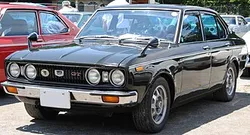

Toyota Carina: Generation 1 A10 Overview
Explore the Toyota Carina, focusing on the first generation A10. Discover its unique features, specifications, and why it remains a classic in Portugal.
The Toyota Carina is a significant model in the automaker’s history, with its first generation—known as the A10—debuting in 1970. This compact car was designed to cater to the growing demand for practical and re...
Technical Specifications
Select Version
Dimensions
Engine
Driving
Others
History and Features
Mycarro AI
Apr 27, 2025
The Toyota Carina is a significant model in the automaker’s history, with its first generation—known as the A10—debuting in 1970. This compact car was designed to cater to the growing demand for practical and reliable transportation during an era marked by economic growth and evolving consumer needs. The Carina A10 followed a successful lineage of models from Toyota and served as a strong entry point into the compact car segment for the brand.
Design and Build
The design of the Toyota Carina A10 was a product of the late 1960s automotive aesthetic, characterized by clean lines and a compact silhouette. The compact proportions of the Carina were visually appealing and practical. It featured a modestly styled front end with rectangular headlights and a chrome grille, including a slightly sloping roof that tapered into a sleek rear. The overall body was designed to offer maximum interior space while maintaining a low center of gravity, vital for its handling dynamics.
The Carina A10 was offered as a two-door and four-door sedan, illustrating Toyota's understanding of different customer preferences. The interior was simple yet functional, focusing on comfort and user-friendliness. The dashboard featured straightforward layouts where drivers could find all necessary controls easily. Material quality was up to the standards expected from Toyota at that time, with durable yet comfortable fabric choices for seating.
Engine and Performance
Under the hood, the Carina A10 came equipped with a range of four-cylinder engines, providing customers with options that delivered varying levels of performance and fuel efficiency. The engine line-up included both carbureted and fuel-injected variants. The 1.2-liter engine was the smallest option, offering economical performance suited for urban driving scenarios. Higher models were equipped with the larger 1.6-liter and 1.8-liter engines, catering to those seeking added power and performance for longer journeys.
The Carina A10 was praised for its balanced handling characteristics and a comfortable ride. It utilized a front-engine, rear-wheel-drive layout, which was typical for compact cars of its era. Its suspension setup, featuring MacPherson struts in the front and leaf springs in the rear, provided a blend of comfort for everyday driving and stability in various conditions.
Market Position and Competitors
Positioning itself within the compact car segment, the Toyota Carina A10 faced competition from various rivals, notably from Japanese automakers like Honda and Nissan. The Carina was designed to appeal to families seeking an economical and reliable vehicle as well as younger individuals looking for a stylish sedan. Toyota successfully marketed the Carina for its dependability, leading to an impression of longevity and low running costs that many customers found appealing.
The Carina played a crucial role in establishing Toyota's reputation for excellence in engineering and customer satisfaction. With a focus on building long-lasting relationships with customers, the Carina A10 managed to create a loyal following, which contributed to its popularity in several key markets including Japan and later, select export markets.
Legacy and Impact
The legacy of the Toyota Carina A10 paved the way for subsequent generations of the Carina model, which would continue to evolve and adapt to changing consumer needs in the automotive industry. The Carina's success in establishing itself as a reliable and functional vehicle inspired Toyota to continue focusing on core principles of quality, efficiency, and value in their future models.
In conclusion, the Toyota Carina Generation 1 (A10) not only marked the entry of the Carina into the automotive market but also reinforced Toyota's foothold in the compact car segment. With its combination of practicality, efficiency, and low-cost maintenance, the Carina A10 left an indelible mark in automotive history, and its legacy continued for decades after its original production run. Enthusiasts today still appreciate the Carina for its robust design and timeless appeal, making it a classic example of Toyota's enduring influence in the automotive landscape.
